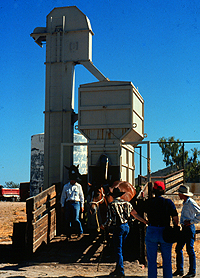

Apparatus for taming wild mustanges by applying pressure over a large area of their body with wheat. This photo shows the entire machine which was designed by Mr. Robinson in Prescott, Arizona.
Wheat flows down the side of the horse stall and covers the horse. His head is outside the box. The wheat is removed by a grain auger located under a floor grating.
Practical experience with the horse pressure box has shown that it has the greatest calming effect on high strong fearful horses. It may not work on horses with a calm disposition. It is most effective on horses where fear is the main cause of bad behavior and it may have little effect on willfully disobedient behavior. When I watched their device being demonstrated a wild horse calmed down and allowed people to touch its head. After it was removed from the box the calming effect lasted about 30 minutes. During this time the trainer can work with the horse and show it that he/she will not hurt it. The horse should be brushed and touched over it's entire body. Touching the horse all over immediately after removal from the wheat box will help in desensitizing the animal. I want to emphasize that the pressure device must be used correctly. Horses must NOT be left in it too long. Thirty minutes is the maximum time a horse should be left in the box buried in wheat. Therapists who work with autistic children have found that the relaxing effects of pressure wear off in about 20 to 30 minutes. The nervous system habituates to the pressure. The maximum calming effect is greatest during the 20 to 30 minute period before the horse would habituate. Leaving a horse in the box too long could cause discomfort.
The trainer must be careful not to frighten the horse. Novel objects should be introdused gradually. When the horse is first placed in the box, the trainer should stroke his head. If the horse shows signs of stress such as hyper-ventilating the trainer should back off and leave the animal alone. Rough sacking out must NOT be used.
Some people have wondered why pressure would have the same effect on both wild horses and people with autism. Both autistics and wild horses have very high fear levels and the nervous system is in a high state of arousal. Pressure is most calming to people and animals that experience anxiety, fear, and high nervous system arousal.

Horse in the pressure box with two gentle horses beside him to keep him company. The bag which is in front of the horse is in mid air. The horse was relaxed by the pressure and did not flinch or react to a bag thrown toward it.
It is my opinion that the horse pressure box is humane provided the horse is not left in the box too long. it must be used by sensitive careful people who care about horses. The pressure box is definitely more humane than some of the very rough training methods that some people use. The box is preferable to some of the common methods where horses are tied up and severly frightened. I have observed some very abusive training methods used on mustanges.
This discussion does not address the issue of whether or not mustanges should be caught and trained. That is an entirely different issue. However, if one wants to train highly flighty and fearful mustanges, the pressure box will probably be very useful.
To read a current article from Western Horseman, written by Dr. Grandin:
Pressure applied to large ageas of the body has a calming effect on the nervous system. Therapists who work with autistic children have found that pressure applied to the child's body has a calming effect. For more information on them refer to:
Temple Grandin's paper describing her "Squeeze Machine"
For more general information on Autism